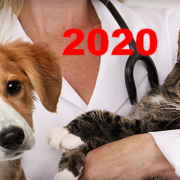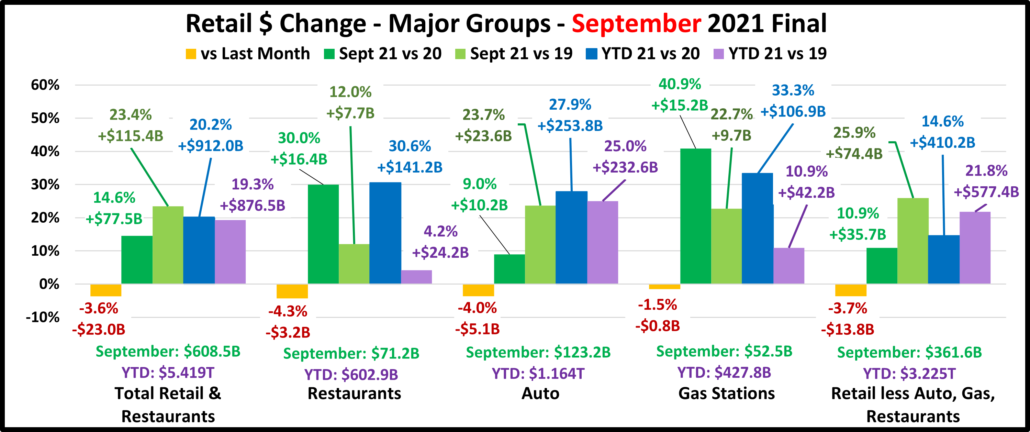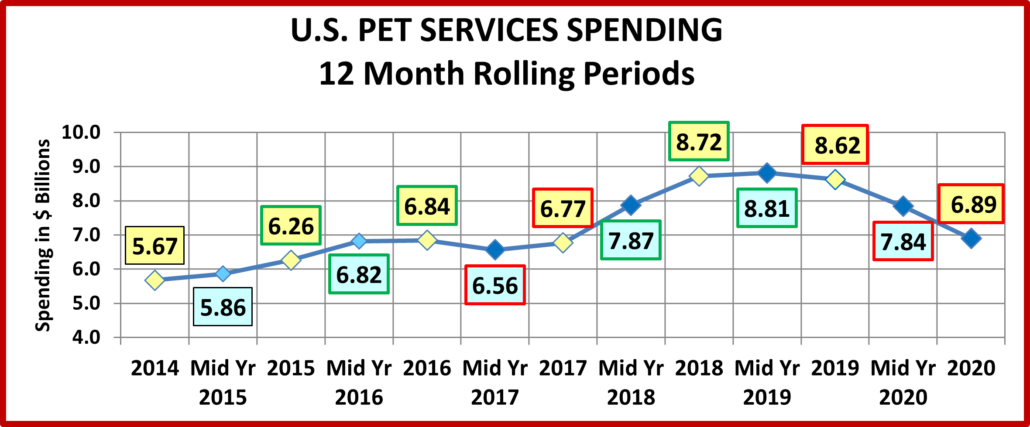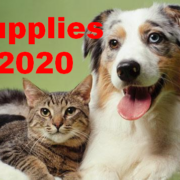2020 U.S. VETERINARY SERVICES SPENDING $24.85B…UP ↑$3.05B
Veterinary Services is the 2nd largest segment in the Pet Industry. High inflation, 3.5+%, caused a reduction in Veterinary visits from 2014>2016. In 2017 inflation slowed (+2.2%) and consumers responded. In 2018 prices turned up (+2.6%) and spending plateaued. In 2019 inflation was +4.1% and Veterinary Spending grew +2.7% so “real” spending was actually down -1.4%. In 2020, COVID drove spending up significantly in “needed” categories, like Veterinary. Spending reached $24.85B, up $3.05B (+14.0%). Inflation was 3.7% so 74% of the growth was real. In this report, we’ll take a closer look at the demographics behind the 2020 numbers. (Note: All 2020 numbers in this report come from or are calculated by using data from the US BLS Consumer Expenditure Interview Survey, rather than their Diary report. The low frequency of Veterinary Visits is still generating an exceptionally high variation on the data collected by the Diary method. Interview seems to be a more logical and accurate way to track Veterinary Service Expenditures.)
Let’s get started. Veterinary Spending per CU in 2020 was $189.35, up 14.8% from $164.88 in 2019. (Note: A 2020 Pet CU (67%) Spent $282.61) More specifically, the increase in Veterinary spending came as a result of:
- 0.8% less CU’s
- Spending 12.8% more $
- …1.8% more often
We’ll take a closer look. But first, the chart below gives an overview of recent Veterinary Spending.
The big spending drop in the first half of 2015 coincided with the upgrade to Super Premium Foods – Trading $. Then consumers began value shopping for Premium Foods and the savings freed up $ for Veterinary Services. Spending began to climb until it flattened out at the beginning of 2017. In 2017, Veterinary inflation slowed markedly in the second half and spending took off. In 2018 prices turned up again and consumers essentially held their ground through 2019. The initial reaction to COVID in 2020 was a drop in spending but the “need focused” consumers then drove a huge increase.
Now, let’s look at Veterinary spending by some specific demographics. First, here is a chart by Income Group
Although not as much as Services and now Food, Veterinary Spending is driven by income. The only group to spend less than 2015 was <$30K. 2020 spending was mixed. The only drop came from the $70>100K income group and the increase was almost equally divided between <$70K & $100K>. The 50/50 break point in $ was $96K, down from $97K in 2019.
National: $189.35 per CU (+14.8%) – $24.85B – Up $3.05B (+14.0%)
- Over $150K (14.1% of CUs) – $375.65/CU (+2.9%) $6.96B, Up $0.56B (+8.7%) This highest income group is the biggest Veterinary Spender as 14.1% of CUs generated 28% of 2020 $. Their $ grew but slower than the overall rate.
- $100>150K (14.4% of CUs) – $267.61/CU (+24.8%) $5.04B, Up $1.14B (+29.1%) Spending by this middle/upper income group slowed in 2019 as prices turned up, but it took off in 2020 as they reacted strongly to their pet needs.
- $70K>100K (15.0% of CUs) – $190.23/CU (-12.4%) $3.74B, Down $0.41B (-9.8%) Their spending has steadily grown since 2016. That changed in 2020 as monetary pressures from the pandemic caused them to spend less.
- $30K>70K (31.1% of CUs) – $149.72/CU (+25.4%) $6.11B, Up $1.14B (+22.9%) This is the 2nd largest group in Veterinary $ and their spending pattern is remarkably similar to the big spending $150K+ group. Vet $ were flat in 2019 but grew strongly in 2020 as they found the money to fulfill their Veterinary needs.
- Under $30K (25.4% of CUs) $89.67/CU (+35.0%) $2.99B, Up $0.62B (+26.2%) This group is very price sensitive. After an increase in all segments in 2017, they dialed back their pet spending on Food and Veterinary Services in 2018. They began to recover in 2019 and spending growth continued in 2020. They are now just 6% below their 2015 $.
Now, here is Veterinary Spending by Age Group
Every group but 35>44 and <25 spent more. The lift came more from increased $ spent rather than visit frequency.
National: $189.35 per CU (+14.8%) – $24.85B – Up $3.05B (+14.0%)
- <25 (3.8% of CUs) – $65.35/CU (-29.7%) – $0.33B – Down $0.35B (-51.7%) The biggest factor in the big spending drop by this youngest group was a 2.2M, -31.2% decrease in CUs. 31.2% fewer CUs spent 32.0% less $ …3.3% more often.
- 25>34 (16.0% of CUs) – $178.05/CU (+43.9%) – $3.74B – Up $1.11B (+42.2%) The commitment of these Millennials to their pets is growing. Their Veterinary $ ticked up in 2019 after being stable for 2 years. In 2020 the $ took off with a 43.9% increase in CU spending. 1.2% fewer CUs spent 37.5% more $ …4.6% more often.
- 35>44 (17.0% of CUs) – $200.58/CU (-11.5%) – $4.47B – Down $0.59B (-11.6%) In 2019, these mostly Gen Xers radically increased their Veterinary spending and they moved to the top in Veterinary $. In 2020 they increased visit frequency but cut back -20% on $. They fell to 3rd 0.1% less CUs spent 20.5% less $ …11.4% more often
- 45>54 (17.2% of CUs) – $221.60/CU (+18.7%) – $5.01B – Up $0.85B (+20.4%) This group has the highest income, but value is important. In 2017, the slowed inflation caused them to spend significantly more money and more often. In 2018, prices turned up and continued to inflate in 2019. Spending dropped precipitously. They fell from the top spot in Veterinary $ and even below their 2015 numbers. 2020 brought a strong recovery with a 20% increase in $. They spent more $ more often and moved up the ladder to #2. 1.5% more CUs spent 11.7% more $…6.2% more often
- 55>64 (19.1% of CUs) – $217.17/CU (+17.2%) – $5.45B – Up $0.90B (+19.8%) This group is all Baby Boomers and was the leader in Veterinary Spending prior to 2015. In 2015 they upgraded to Super Premium Food and Vet Spending fell. In 2016 they began to spend more again on Veterinary Services. In 2017, as inflation significantly slowed, they regained the top spot. In 2018 Veterinary prices began to strongly inflate again. Their spending fell and continued down into 2019. In 2020 their frequency fell but they spent a lot more. They’re back on top in Veterinary Spending because 2.2% more CUs spent 25.2% more $ …6.4% less often
- 65>74 (15.6% of CUs) – $200.22/CU (+22.6%) – $4.09B – Up $0.87B (+27.1%) This group is growing in numbers and very price sensitive. They are Boomers so they are committed to their pets. In 2020 their visit frequency was down due to the pandemic, but they spent 37% more $. 3.7% more CUs spent 37.0% more $ …10.5% less often
- 75> (11.2% of CUs) – $118.92/CU (+17.0%) – $1.75B – Up $0.25B (+16.7%) This group of oldest Pet Parents has a strong commitment to their pets – in 2015 a $1B increase in Veterinary Spending. In 2016, they upgraded their food. In 2017 they increased spending in Food, Supplies and Services. In 2018, they turned their attention back to Veterinary and in 2019 they had increases in all but Supplies. The pandemic hit them hard, but they still took care of their pets with increased Veterinary spending. 0.2% less CUs spent 14.9% more $…1.8% more often
Now, let’s take a look at some other key demographic “movers” behind the 2020 Veterinary Spending numbers.
Veterinary spending increased by $3.05B (+14.0%) in 2020. Even with a high 3.7% inflation rate, 74% of the growth was real. 2020 had widespread positivity. 82 of 96 demographic segments (85.4%) spent more on Veterinary Services while only 14 segments spent less. In 4 categories all segments spent more. However, there was some turmoil as 8 flipped from first to last or vice versa while 4 segments maintained their position from 2019.
Half of the segments were the “usual” winners and losers. On the winning side were:
- Mgrs/Professionals
- Homeowners w/Mtge
- White, Not Hispanic
- 2 People
- Married Couple Only
- Adv College Degrees.
The “usual” losers were equal in number and included:
- Singles
- African Americans
- Renters
- No earner Singles
- <HS Grads
- Gen Z
That means that there were relatively few surprises:
- Winners: Center City, 25>34 yrs old
- Losers: Suburbs, 35>44 yrs old
In our earlier analysis we saw that the increase was widespread across Income and Age groups. Only 1 income group, $70>99K and 2 age groups, <25 and 35>44 spent less. There were 4 categories in which all segments spent more. The nature of these categories illustrates how truly widespread the lift in Veterinary $ was.
- Race/Ethnic
- Housing
- CU sizes
- Area Type
There had been a strong youth movement in Veterinary Spending from the <45 crowd. That changed in 2020 as the 45> groups were up $2.87B which accounted for 94% of the segment’s increase. We should also note that the 65> group is now the only group with a spending increase for 3 consecutive years.
Generations still seems to be the most popular demographic measurement and it was almost all good news as Gen Z was the only generation with a decline in Veterinary Spending in 2020. Baby Boomers bounced back to the top spot in Veterinary $ after 2 years of big decreases. Boomers fueled the growth of the Pet Industry and remain the overall biggest pet spenders. In Veterinary $, their spending in 2017 was greater than all of the younger generations combined. In 2020, the younger groups spent 50% more than the Boomers. Because of their sheer numbers, Boomers will remain a force in the industry for years to come. but the “torch” is slowly but surely being passed.




















